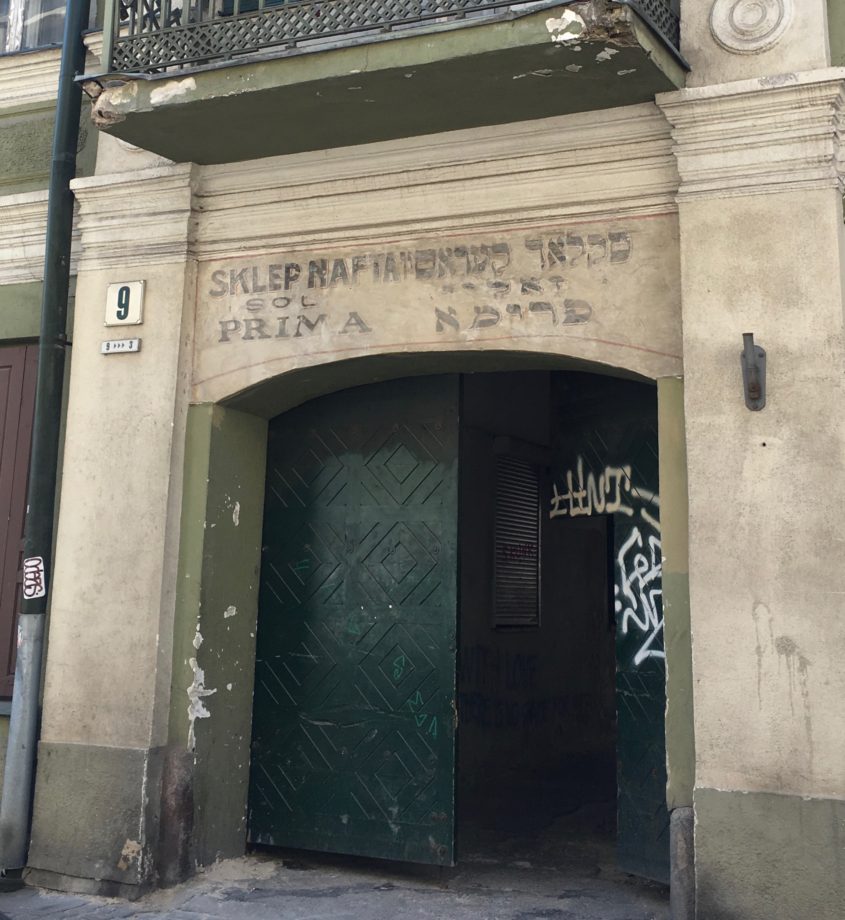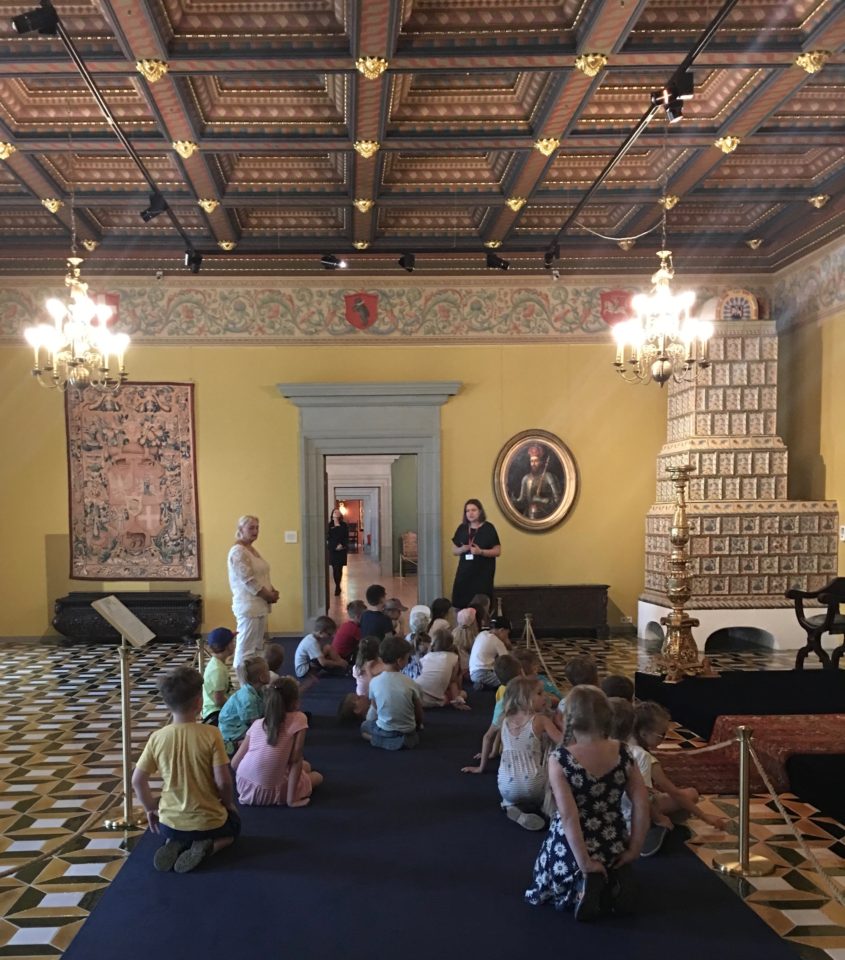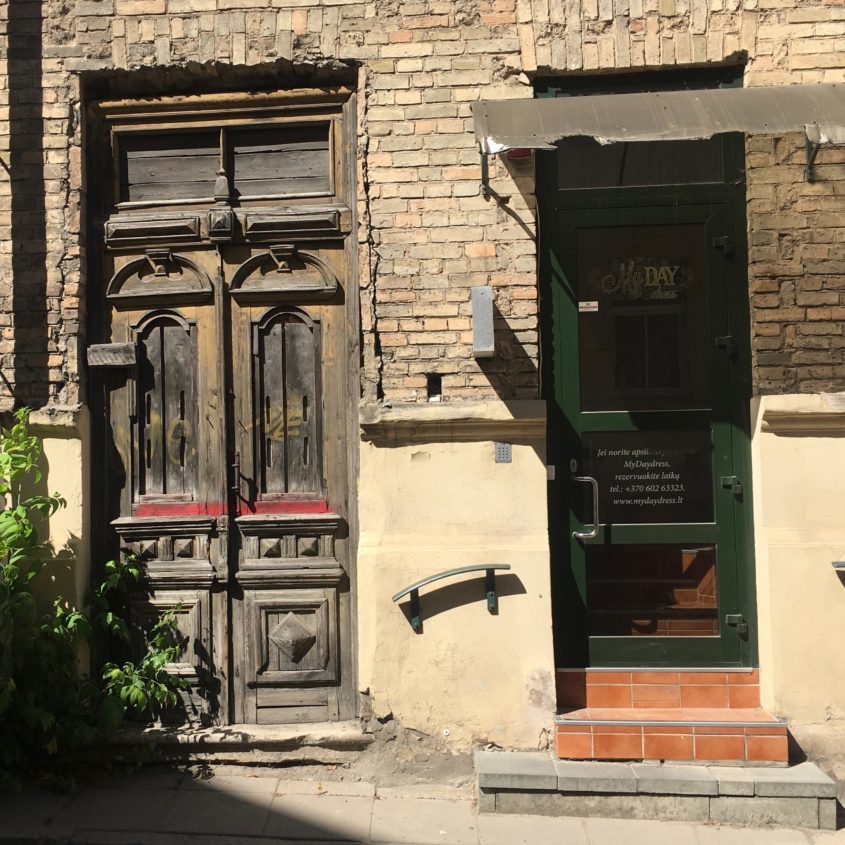Next to our hotel is a small cafe/bar (The Love Story) which shares space with a jeweler (young, blonde handsome, multi-lingual) who works in a glass box when he is not hopping out to mingle with the clientele – mostly well-heeled young women. It does seem strange to have a jeweler in a coffee shop that is also a bar — as well as an ice cream shop, but rents are high in the gentrified heart of what was once the old Vilna Ghetto. The evening we are there a group of women and their small children – all perfectly put together – gather under a cascade of fake orchids while the moms drink champagne and the kids eat ice cream – which they manage without dripping all over themselves, or leaping over the furniture, or begging their mothers to pay attention to them – a good thing, as the mothers are pretty into their champagne. It’s about 8:00 in the evening in Vilnius in a heat wave and the sun has no intention of setting any time soon.

Color in the old city 
Heat wave; everyone outside. 
Glassblowers guild fresco on the beautifully restored Stiklai Hotel
There are about 3 million Lithuanians – the population of Greater Boston; a nation that was the last in Europe to adopt Christianity (1385) but when they did, became pretty ferociously Catholic. Lithuanian saints (ones you’ve never heard of) refused to renounce Christ during on-going pagan festivals and were tortured to death in creative ways, earning them a place on the walls of churches and cathedrals. Evidently one of the most effective conversion techniques was to offer anyone willing to be baptized a new white linen shirt — an awesome gift. People converted in droves, and often more than once – piling up those new shirts. True story? I wonder about who was turning out those shirts in the 1300s – not Chinese factories. Probably newly converted young women devoted to the cause…

We sit in delightful restaurants eating farm-fresh food served by cautiously cheerful waiters and eavesdrop on groups of young folks speaking English in various accents and discussing their business start-ups, tech accelerators, and innovation centers in the Baltics. They are young and serious (many drinking non-alcoholic beer) and can’t be more than 30 – young enough to have no memory of Soviet dominance and drabness, and determined to remake themselves in the 21st century. Good riddance to the long nightmare of the 1900s.

Modern Pegasus 
10:00 sunset. 
Babushka with boots
I have a choice between paying attention to the bright and airy scenes around me, or being dragged into the not-so-distant past. You can’t be Jewish and not recognize that Lithuanian Jews were virtually wiped out between 1941-43. And not in organized camps, but in freelance massacres which can only happen with the (fairly enthusiastic) participation of the local population, spurred on by the Naxis. We visit Poner (site of mass killings of 70,000 Jews from the Vilnius ghetto) on a hot, sunny morning. Birds sing, the forest is quiet, trees rustle in the gentle breeze. A freight train chugs through on the same tracks that once led families from Vilnius on holiday and then to their death in pits. There are two or three small groups roaming through; otherwise we are alone. After a tour of Jewish Vilnius, a sober visit to the Jewish Museum, a break-down in the Holocaust Museum, I need to get back to the present.

A Mogen David scratched into the side of a wall 
The Vilna Gaon welcomes you. 
Not yet gentrified. The remains of a small shul. 
Zhid street. Old and New. 
A shop sign in Polish and Yiddish still visible 
An effort to revive the old Ghetto imagery.
The heat wave continues until Vilnius reaches 35 C which is unheard of for an early June day. Stores and restaurants have no air-conditioning; and we retreat first to a terrific modern art museum just completed by Daniel Liebeskind, and then to an in-depth reconstruction of the original Grand Duke’s royal palace (and the history of Lithuania) which must have cost tens of millions of euros and taken 20 years.

Museum of Modern Art staircase. 
Munchkins behaving in the Royal Palace 
Doors to the University of Lithuania library 1547.
At one point, the Grand Duchy of Lithuania was the largest empire in Europe, stretching from the Baltic to the Black Sea, encompassing much of Poland, Belorus, Ukraine and the Crimea. No fool, the Grand Duke invited the Jews being kicked around Europe or massacred in the Crusades to come and settle. Then followed the marching back and forth of empires and armies from West (Poland, Prussia) and East (Russia) and north (Sweden) and south (Ottomans) finally absorbing what was left of Lithuania into the Russian empire. When Russia pushed most of its Jews into what became the Pale of Settlement (Lithuania, Eastern Poland, Belarus, Ukraine) – Vilnius became its “Jerusalem” – center of sober learning and Talmudic study – and railed against the upstart Hasidic sects as heretics. Along came the decree that Jewish men at the age of 15 had to be inducted into the Czar’s army for 25 years, and many of them had the brains, luck and pluck to get the hell out. Among them my paternal grandparents and great grandparents. Litvaks dispersed to Canada, New York, London, South Africa and thank God they did – before the nightmare of war, mass murder, and 45 yr Soviet Occupation
There is – literally – nothing left. Whatever the Nazis didn’t destroy, the Soviets bull-dozed. While Vilnius has done a decent job of trying to put together a Jewish itinerary, there is nothing but shadow. I found it touching that most of the guides were not Jewish and most of the earnest tour attendees weren’t Jewish either. (Many Germans; so interesting…). There appears to have been a reckoning between this generation and their parents – did you collaborate? Where were you? As expected, the answers are: we were trying to survive, to figure out who was worse – the Nazis or the Soviets. Whatever their role, they paid for it for the next miserable 45 years of Soviet life.
But it’s a new world; and good riddance to the old. But not to the old city – one of the largest intact medieval cities in Europe; architects and developers are doing a good job of keeping Disney effects at bay and restoring the narrow lanes and pastel buildings with sanity and integrity. Tourists have arrived; but it’s not Prague yet.

Smack in the middle of the city… 
Old and new… 
Exuberant baroque 
Old Ghetto today 
Old Ghetto early 20th century
